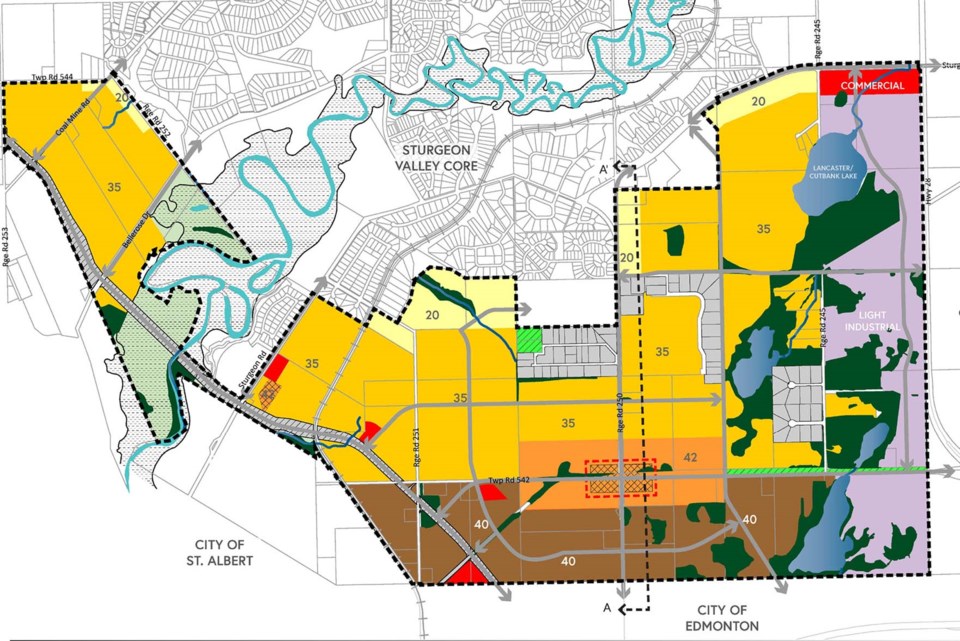Some Sturgeon Valley residents aren’t eager to see their community, which borders St. Albert and Edmonton, accept more, higher-density housing, according to a recent survey.
Despite the survey’s finding that nearly 80 per cent of respondents in Sturgeon Valley South don’t support building neighbourhoods with more diverse housing options and greater density — and that nearly 70 per cent of respondents in the Sturgeon Valley Core felt similarly — the county doesn’t have much choice in the matter, said Mayor Alanna Hnatiw.
In 2021, Sturgeon County approved two new area structure plans for Sturgeon Valley that allow for the construction of denser neighbourhoods, along with some commercial and light industrial.
At the time, the county hosted public consultations online and by phone. But once development applications started to roll in, the county heard from residents who felt they had been left out of the consultation process, prompting it to conduct an information session and a survey in late May and early June this year, Hnatiw said.
Current plans propose Sturgeon Valley South, which borders St. Albert and Edmonton, accept developments with at least 35 housing units per hectare and allow for townhomes and low-rise apartment buildings. Developments near the Sturgeon Valley Core would see less density, with 20 homes per hectare, whereas developments closer to Edmonton would reach up to 45 units.
"There would be transitions to provide a ‘buffer’ between existing neighbourhoods and denser future neighbourhoods,” says a report from the county.
Existing neighbourhoods in the Sturgeon Valley Core, north of Sturgeon Valley South, would receive no new development. However, new neighbourhoods are proposed for land that surrounds existing neighbourhoods.
It’s a big change for an area that is populated mostly by acreages, bushes and farmland.
And residents who participated in the consultation and survey largely shared the opinion they want growth in the area to be limited to low-density development.
“Residents would prefer to still see two units per hectare,” Hnatiw said. “That type of development is no longer approved in the Edmonton region. The growth management board sets densities closer to 20 units per hectare, up to 45 units per hectare.”
Municipalities today face different challenges managing growth and housing options than they did 20 years ago, Hnatiw said.
Alberta’s population is surging upwards, and rural communities are also seeing the change.
In the next 25 years, Sturgeon Valley could grow by 13,800 residents, according to a report from the county.
The report projects that Sturgeon Valley could be adding 145 new homes per year in the near future, and up to 315 homes further along the 25-year trajectory.
Without higher densities, sprawl will eat up more good agricultural land, Hnatiw said. And without a larger taxpayer base, utilities and infrastructure for rural properties will grow increasingly unaffordable.
Hnatiw acknowledged Sturgeon Valley will look quite different in 25 years, and some current residents might not like the change of scenery.
“Our council is concerned with the residents of today, but also with the residents 10 years down the road,” Hnatiw said. “What kind of community are we building for the people who are here and for the people who are coming?”
The tensions facing rural communities on the edge of growing cities “will never go away,” Hnatiw said.
“I do hope that people continue to stay engaged and also be a part of the solution,” she said. “To just say, ‘No, I don't want what you're doing,’ but to not come up with a solution — then how else can we manage to provide homes for the people who are coming here to fill the jobs that we are blessed to have in this region and in Alberta? How do we manage all that?”
“We can't all just move to an area and then shut the door and say nobody else can come here.”
Participants in the county’s survey and information session identified increased crime and environmental impacts as major concerns with new development.
They identified the area’s peaceful, quiet lifestyle; green, open spaces; nature and wildlife; agricultural landscape; property values; and lower taxes as “qualities to protect and preserve.”




